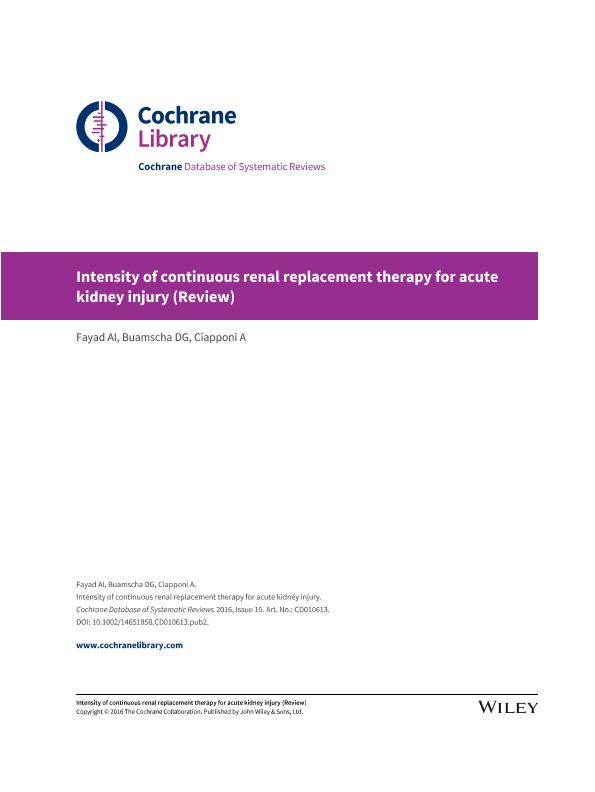Mostrar el registro sencillo del ítem
dc.contributor.author
Fayad, Alicia I.
dc.contributor.author
Buamscha, Daniel G.
dc.contributor.author
Ciapponi, Agustín

dc.date.available
2018-07-26T20:07:45Z
dc.date.issued
2016-10
dc.identifier.citation
Fayad, Alicia I.; Buamscha, Daniel G.; Ciapponi, Agustín; Intensity of continuous renal replacement therapy for acute kidney injury; John Wiley & Sons Ltd; Cochrane Database of Systematic Reviews; 2016; 10; 10-2016; 1-3
dc.identifier.issn
1469-493X
dc.identifier.uri
http://hdl.handle.net/11336/53233
dc.description.abstract
Background: Acute kidney injury (AKI) is a common condition among patients in intensive care units (ICU), and is associated with substantial morbidity and mortality. Continuous renal replacement therapy (CRRT) is a blood purification technique used to treat the most severe forms of AKI but its effectiveness remains unclear. Objectives: To assess the effects of different intensities (intensive and less intensive) of CRRT on mortality and recovery of kidney function in critically ill AKI patients. Search methods: We searched Cochrane Kidney and Transplant's Specialised Register to 9 February 2016 through contact with the Information Specialist using search terms relevant to this review. Studies contained in the Specialised Register are identified through search strategies specifically designed for CENTRAL, MEDLINE, and EMBASE; handsearching conference proceedings; and searching the International Clinical Trials Register (ICTRP) Search Portal and ClinicalTrials.gov. We also searched LILACS to 9 February 2016. Selection criteria: We included all randomised controlled trials (RCTs). We included all patients with AKI in ICU regardless of age, comparing intensive (usually a prescribed dose ≥ 35 mL/kg/h) versus less intensive CRRT (usually a prescribed dose < 35 mL/kg/h). For safety and cost outcomes we planned to include cohort studies and non-RCTs. Data collection and analysis: Data were extracted independently by two authors. The random-effects model was used and results were reported as risk ratios (RR) for dichotomous outcomes and mean differences (MD) for continuous outcomes, with 95% confidence intervals (CI). Main results: We included six studies enrolling 3185 participants. Studies were assessed as being at low or unclear risk of bias. There was no significant difference between intensive versus less intensive CRRT on mortality risk at day 30 (5 studies, 2402 participants: RR 0.88, 95% CI 0.71 to 1.08; I2 = 75%; low quality of evidence) or after 30 days post randomisation (5 studies, 2759 participants: RR 0.92, 95% CI 0.80 to 1.06; I2 = 65%; low quality of evidence). There were no significant differences between intensive versus less intensive CRRT in the numbers of patients who were free of RRT after CRRT discontinuation (5 studies, 2402 participants: RR 1.12, 95% CI 0.91 to 1.37; I2 = 71%; low quality of evidence) or among survivors at day 30 (5 studies, 1415 participants: RR 1.03, 95% CI 0.96 to 1.11; I2 = 69%; low quality of evidence) and day 90 (3 studies, 988 participants: RR 0.98, IC 95% 0.94 to 1.01, I2 = 0%; moderatequality of evidence). There were no significant differences between intensive and less intensive CRRT on the number of days in hospital (2 studies, 1665 participants): MD -0.23 days, 95% CI -3.35 to 2.89; I2 = 8%; low quality of evidence) and the number of days in ICU (2 studies, 1665 participants: MD -0.58 days, 95% CI -3.73 to 2.56, I2 = 19%; low quality of evidence). Intensive CRRT increased the risk of hypophosphataemia (1 study, 1441 participants: RR 1.21, 95% CI 1.11 to 1.31; high quality evidence) compared to less intensive CRRT. There was no significant differences between intensive and less intensive CRRT on numbers of patients who experienced adverse events (3 studies, 1753 participants: RR 1.08, 95% CI 0.73 to 1.61; I2 = 16%; moderate quality of evidence). In the subgroups analysis by severity of illness and by aetiology of AKI, intensive CRRT would seem to reduce the risk mortality (2 studies, 531 participants: RR 0.73, 95% CI 0.61 to 0.88; I2 = 0%; high quality of evidence) only in the subgroup of patients with post-surgical AKI. Authors' conclusions: Based on the current low quality of evidence identified, more intensive CRRT did not demonstrate beneficial effects on mortality or recovery of kidney function in critically ill patients with AKI. There was an increased risk of hypophosphataemia with more intense CRRT. Intensive CRRT reduced the risk of mortality in patients with post-surgical AKI.
dc.format
application/pdf
dc.language.iso
eng
dc.publisher
John Wiley & Sons Ltd

dc.rights
info:eu-repo/semantics/openAccess
dc.rights.uri
https://creativecommons.org/licenses/by-nc-sa/2.5/ar/
dc.subject
Intensity of Continuous Renal Replacement Therapy For Acute Kidney Injury
dc.subject.classification
Salud Ocupacional

dc.subject.classification
Ciencias de la Salud

dc.subject.classification
CIENCIAS MÉDICAS Y DE LA SALUD

dc.title
Intensity of continuous renal replacement therapy for acute kidney injury
dc.type
info:eu-repo/semantics/article
dc.type
info:ar-repo/semantics/artículo
dc.type
info:eu-repo/semantics/publishedVersion
dc.date.updated
2018-07-25T13:57:06Z
dc.journal.volume
2016
dc.journal.number
10
dc.journal.pagination
1-3
dc.journal.pais
Reino Unido

dc.journal.ciudad
Londres
dc.description.fil
Fil: Fayad, Alicia I.. Gobierno de la Ciudad de Buenos Aires. Hospital General de Niños ; Argentina
dc.description.fil
Fil: Buamscha, Daniel G.. Gobierno de la Ciudad de Buenos Aires. Hospital de Pediatría ; Argentina
dc.description.fil
Fil: Ciapponi, Agustín. Consejo Nacional de Investigaciones Científicas y Técnicas; Argentina. Instituto de Efectividad Clínica y Sanitaria; Argentina
dc.journal.title
Cochrane Database of Systematic Reviews

dc.relation.alternativeid
info:eu-repo/semantics/altIdentifier/doi/https://dx.doi.org/10.1002/14651858.CD010613.pub2
dc.relation.alternativeid
info:eu-repo/semantics/altIdentifier/url/http://cochranelibrary-wiley.com/doi/10.1002/14651858.CD010613.pub2/abstract
Archivos asociados
